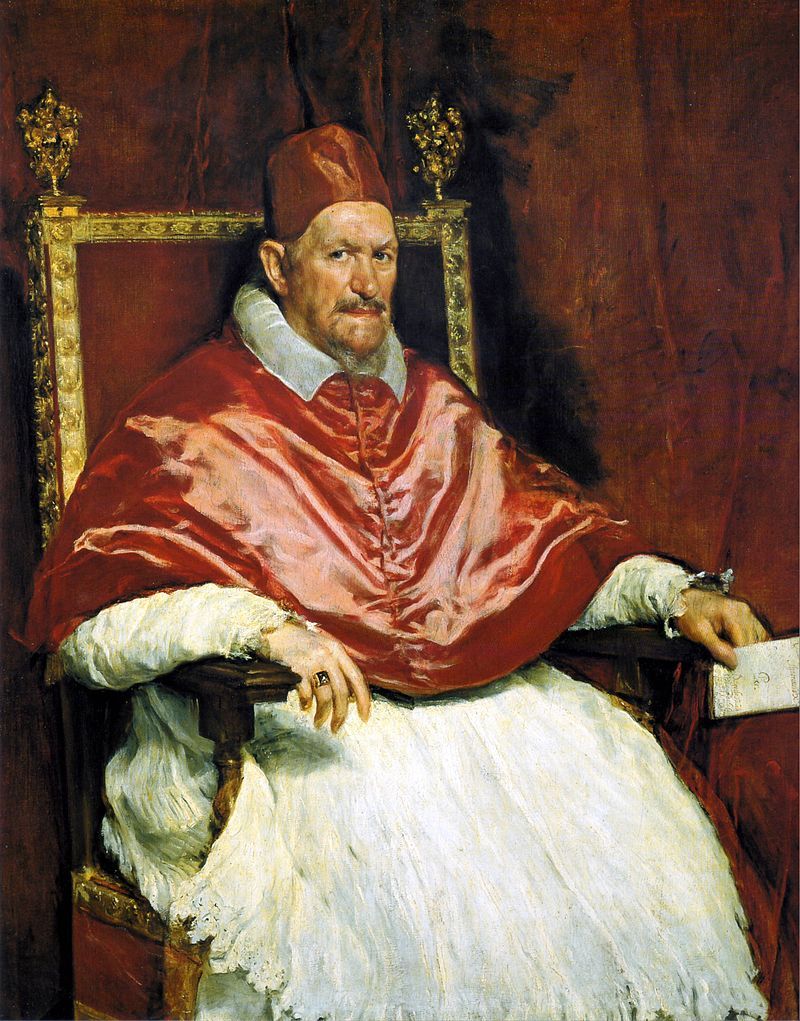There are pictures that are worth for the entire exhibition. And are not always those we occasionally see, isolated, in museums; but there are exceptions to this rule, as when bring us home the “Innocent X” by Velázquez. A few years ago that outrageous portrait temporarily visited the National Prado Museum. The problem, in such cases, is queuing or seeks recommendation to do it with peace of mind, especially if you live outside of Madrid. Or establishing a date and time… that comes down to five minutes! And being part of a group. They are the problems derived from the mass culture marketing.

Portrait of Innocent X
Oil on canvas, 140 x 120 cm. Diego Velázquez, 1650. Galleria Doria Pamphili. Roma (Italy)
You have a consolation travelling to Rome though, or take the chance during a trip there, to go along the Corso until the number 305, very close to Piazza Venezia, and enter a passage relatively well signposted to the exceptional Palazzo Doria-Pamphili, which hosts the also known as Doria-Pamphili Gallery. There, a labour day and at a convenient time, let’s say by noon, is for one the immense fortune to arrive, mostly solo, to the dressing room that houses it and which was purposed built in 19th century. There is the Innocent X (born Giovanni Battista Pamphili) by Velázquez, performed in the summer of 1650, in the only company of the bust executed by Bernini. And it is for one only, if you have that fortune. Nobody is going bothering you; No one will come to “push” so you’re done and you go. No one will tell you ‘what an horror!’ or that your 5 minutes have been completed. You can stay half an hour or longer and enjoy such an incredible fortune. You can meditate art as few times in life. And to this magnitude, the question: how to believe that a picture painter like this had not reached yet its summit? Of course he reached it! Finished the feast and renewed internally by such creative illusion, after all, you hope to wake up the meditation and the dream of the time and back at the Corso only a good Osteria or Trattoria will be duly temper “around the world”, and if you have chosen good, your spirit comforted.
Goya would visit such “unique exhibition”? Would the Aragonese see this marvel of portrait? I do not know it, but he must have seen it; especially knowing Goya’s admiration by his compatriot Diego Velázquez. And because there was Goya, in Rome of 1770, when he made his trip to Italy, in the manner of the good and applied European artist in his particular grand tour. He has no more than 24 years. This means, according to the common law of that time, 26 years yet to suffer. But as he is a genetic prodigy, is remaining still, indeed, 58 years of thoughtful art.
Writes Katharina Hegewisch “The art puts a mirror against the individual to whom appears the reflection of his nostalgia, of his problems, his troubles and utopias; Returns the private public and allows to live experiences by proxy. It functions as a seismograph that records the fluctuations of existence; it forces us to move, unlock, excites and provokes. “(l’Art de l’exposition, Ed. Du Regard.)” Paris. 1998).
So, today for little fan to fine arts we may be, all have visited exhibitions which were recorded in our retina and memory, and others that were quickly forgotten, fairly or unfairly. And Hegewisch added, “Each one receives the art differently. Knowing if an exhibition will be perceived as a temple, a hell or a fair, if it will be transformed in triumph or in financial fiasco, those are the elements on which not can influence but partially. Success is a relative concept, which for the organizer is defined differently that for the artist or the public.”
As mentioned above, there are pictures that are worth for the entire exhibition, but perhaps as important, or more, is to know how to meet the artworks and give them and added value if even possible. It is a moral and intellectual added value that constitutes an inalienable right. I am referring to those curators with exhibit criteria that know how to do it; they have that capacity, that noble virtue that makes them responsible for the content and shape of the exhibition, as well as the staging. Certainly there are them, by misfortune, whose grace resides in countless places in the human body and that provide us with the misfortune to compose real clunkers, made based on good artworks or, even worse, rare mix of good and bad works. Yes, it is all a disgrace that some well-meaning but little capable patrons entrusted awkwardly, to second-rate characters, tasks that rather than seek good examples end up becoming a canon for the reprehensible. In the best of cases, will be a sad waste of time and money, going straight to oblivion.
We are involuntary witnesses of cases like this and regret the extreme insufficiency and how some have things completely upside down; as it should had never be done, or even attempted. And we wonder how can they think such folly to this genie? But, where have the eyes? And we are not even consoled when knowing that this not only occurs with exhibitions, but also in cinema, theatre, in publishing and in so many other disciplines or acid striking situations.
Returning to the Doria-Pamphili collection, since the 19th it has the dressing room built just to host the famous portrait of Velázquez and seems that from the 18th century there is in that well-deserving institution a document detailing precisely the placement that should have every picture, according to criteria of symmetry and stylistic affinity. It isn’t bad, is it? But you cannot squeeze a rock, or set formulas to provide infallible methods. Free will, the lucky coincidence, the sense of proportion, the golden number, the trained eye, the spatial vision, knowledge of the artist and his work, the experience, symmetry, time, well directed vocation, assimilated knowledge, virtue of distinguishing, taste, the opportunity, the winks of intelligence, guidance, well toned senses, sense of smell, viewing, meditation on art, hearing, stylistic affinity, the lighting, the meaning of colour, shape and proportion, sensitivity, contour, moisture and even the magnetism… objectively and subjectively worth and are used simultaneously and successively by those who can and want to do it. And we could add more and more constraints presided over by the study and good education, but cited the magnetism, even though it may be taken out of context, allow me to highlight a paragraph that has touched me from the book “Lord of the World”, by Robert Hugh Benson (Christianity Editions. Madrid, 2013). It reads as follows:
… “Gradually realized that this crowd was like no other that had seen. To his inner sense, it appeared presenting one greater than any other unit. I could feel the magnetism in the air. Something like the feeling that was in process a creative act, whereby thousands of individual cells were being amalgamated more and more every moment in a huge sensitive being with desire, emotion and consciousness. The voices cry seemed to make sense only as the reactions of the creative power that expressed to himself.”
Yes indeed, those very few works of art cut off from the world; these meagre exhibitions whose internal coherence issues magnetism, emotions and manifest spirituality; that certainly are, that can be seen and enjoyed; that teach intellectual courage and show the audacity of its organizers and that are what exemplary distinguishes a few museums, institutions, patrons and organizers from others. But there is no need to remove with a stroke everything that does not reach excellence. It’s enough and excess not saying to the world: look, my work, my exhibition is wonderful, magnificent and exemplary. Instead of deploring its extreme inadequacy and very humbly ask for forgiveness. It’s enough with a minimum of prudence, modesty and humility before a well intentioned work; spare all pride. The greatest know and practice. Those who are not, to our misfortune, still ignore it. Let us not be confused.
Gonzalo de Diego
